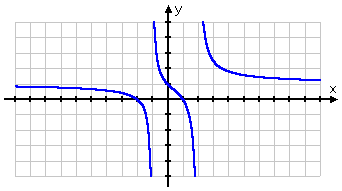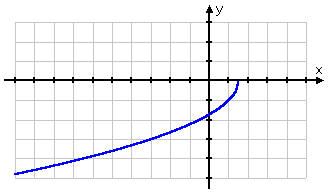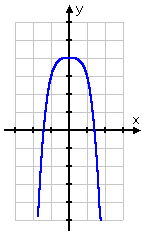how to find the domain
Functions: Domain and Range
Let's return to the subject of domains and ranges.
When functions are first introduced, you will probably have some simplistic "functions" and relations to deal with, usually being just sets of points. These won't be terribly useful or interesting functions and relations, but your text wants you to get the idea of what the domain and range of a function are. Small sets of points are generally the simplest sorts of relations, so your book starts with those.
For instance:
Content Continues Below
-
State the domain and range of the following relation. Is the relation a function?
{(2, –3), (4, 6), (3, –1), (6, 6), (2, 3)}
The above list of points, being a relationship between certain x 's and certain y 's, is a relation. The domain is all the x -values, and the range is all the y -values. To give the domain and the range, I just list the values without duplication:
domain: {2, 3, 4, 6}
range: {–3, –1, 3, 6}
(It is customary to list these values in numerical order, but it is not required. Sets are called "unordered lists", so you can list the numbers in any order you feel like. Just don't duplicate: technically, repetitions are okay in sets, but most instructors would count off for this.)
While the given set does indeed represent a relation (because x 's and y 's are being related to each other), the set they gave me contains two points with the same x -value: (2, –3) and (2, 3). Since x = 2 gives me two possible destinations (that is, two possible y -values), then this relation is not a function.
Note that all I had to do to check whether the relation was a function was to look for duplicate x -values. If you find any duplicate x -values, then the different y -values mean that you do not have a function. Remember: For a relation to be a function, each x-value has to go to one, and only one, y-value.
-
State the domain and range of the following relation. Is the relation a function?
{(–3, 5), (–2, 5), (–1, 5), (0, 5), (1, 5), (2, 5)}
I'll just list the x -values for the domain and the y -values for the range:
domain: {–3, –2, –1, 0, 1, 2}
range: {5}
This is another example of a "boring" function, just like the example on the previous page: every last x -value goes to the exact same y -value. But each x -value is different, so, while boring,
this relation is indeed a function.
In point of fact, these points lie on the horizontal line y = 5.
By the way, the name for a set with only one element in it, like the "range" set above, is "singleton". So the range could also be stated as "the singleton of 5"
There is one other case for finding the domain and range of functions. They will give you a function and ask you to find the domain (and maybe the range, too). I have only ever seen (or can even think of) two things at this stage in your mathematical career that you'll have to check in order to determine the domain of the function they'll give you, and those two things are denominators and square roots.
-
Determine the domain and range of the given function:
The domain is all the values that x is allowed to take on. The only problem I have with this function is that I need to be careful not to divide by zero. So the only values that x can not take on are those which would cause division by zero. So I'll set the denominator equal to zero and solve; my domain will be everything else.
x 2 – x – 2 = 0
(x – 2)(x + 1) = 0
x = 2 or x = –1
Then the domain is "all x not equal to –1 or 2".
The range is a bit trickier, which is why they may not ask for it. In general, though, they'll want you to graph the function and find the range from the picture. In this case:

As you can see from my picture, the graph "covers" all y -values; that is, the graph will go as low as I like, and will also go as high as I like. For any point on the y -axis, no matter how high up or low down, I can go from that point either to the right or to the left and, eventually, I'll cross the graph. Since the graph will eventually cover all possible values of y , then:
the range is "all real numbers".
-
Determine the domain and range of the given function:
The domain is all values that x can take on. The only problem I have with this function is that I cannot have a negative inside the square root. So I'll set the insides greater-than-or-equal-to zero, and solve. The result will be my domain:
–2x + 3 ≥ 0
–2x ≥ –3
2x ≤ 3
x ≤ 3/2 = 1.5
Then the domain is "all x ≤ 3/2".
The range requires a graph. I need to be careful when graphing radicals:

The graph starts at y = 0 and goes down (heading to the left) from there. While the graph goes down very slowly, I know that, eventually, I can go as low as I like (by picking an x that is sufficiently big). Also, from my experience with graphing, I know that the graph will never start coming back up. Then:
the range is "all y ≤ 0".
-
Determine the domain and range of the given function:
y = –x 4 + 4
This is just a garden-variety polynomial. There are no denominators (so no division-by-zero problems) and no radicals (so no square-root-of-a-negative problems). There are no problems with a polynomial. There are no values that I can't plug in for x . When I have a polynomial, the answer for the domain is always:
the domain is "all x ".
The range will vary from polynomial to polynomial, and they probably won't even ask, but when they do, I look at the picture:

The graph goes only as high as y = 4, but it will go as low as I like. Then:
The range is "all y ≤ 4".
how to find the domain
Source: https://www.purplemath.com/modules/fcns2.htm
Posted by: barkerwishis.blogspot.com

0 Response to "how to find the domain"
Post a Comment